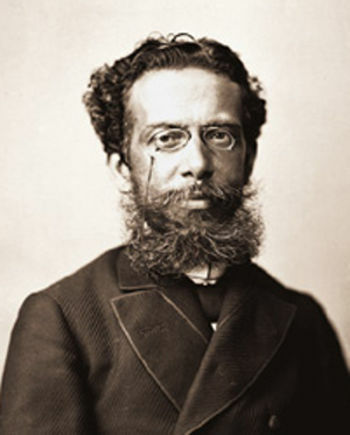question 1
Read two excerpts from Iracema by José de Alencar and judge the items in REAL or FALSE according to the literary movement to which she belongs.
Section 1
"- Right now, Tupã is not with you! replied the chief. The shaman laughed; and his sinister laugh echoed through space like the otter's furrow. - Hear its thunder and tremble in your bosom, warrior, like the earth in its depths. Araquém uttering this terrible word, he advanced into the middle of the hut; there he lifted the great stone and stamped his foot hard on the ground; suddenly the earth opened up. From the deep den came a ghastly moan, which seemed torn from the bowels of the cliff. Irapuã didn't tremble, nor started in fright; but he felt the light tremble in his eyes, and the voice on his lips. – The lord of thunder is for you; the warlord will be for Irapua: said the chief. The grim warrior left the hut (…)".
Section 2
“Suspicious rumor breaks the sweet harmony of the nap. The virgin lifts her eyes, may the sun not dazzle; sight of him is disturbed. Before her and all beholding her is a strange warrior, if he is a warrior and not some evil spirit of the forest. He has on his face the white of the sands that border the sea; in the eyes the sad blue of the deep waters. Unknown weapons and unknown fabrics cover his body. It was quick, like the look, the gesture of Iracema. The arrow embedded in the bow broke. Drops of blood bubble on the face of the stranger. At first impulse, the quick hand fell on the cross of the sword; but then he smiled."
a) ( ) The work belongs to the first romantic generation in Brazil that was based on the binomial “nationalism-indianism”.
b ( ) The author, José de Alencar, avoids using poetry, since the work is a text narrated in prose.
c) ( ) The relationship between Iracema and Martim characterizes a union of peoples, indigenous and white, and the union of cultures, civilized European and wild indigenous.
d) ( ) The author uses a language full of images and metaphors to represent indigenous thought.
e) ( ) The Indian's thought is realistic and, therefore, it distances itself a lot from poetry.
question 2
Read an excerpt from the poem Navio Negreiro de Castro Alves
the slave ship
I
'We are at sea... doudo in space
Moonlight plays — golden butterfly;
And the vacancies after him run... get tired
Like restless infant mob.
'We are at sea... from the firmament
The stars leap like foams of gold...
The sea in turn lights up the ardentias,
— Constellations of the liquid treasure...
'We are at sea... two infinities
There they close in an insane embrace,
Blue, gold, placid, sublime...
Which of the two is heaven? which ocean...
'We are in the middle of the sea.... opening the candles
In the hot panting of seas,
Brigue sailboat runs to the flower of the seas,
How the swallows graze the wave...
Where do you come from? where you go? of the errant ships
Who knows the direction if the space is so big?
In this sahara the steeds the dust raises,
They gallop, fly, but leave no trace.
Very happy who can there at this hour
Feel the majesty of this panel!
Below — the sea above — the firmament...
And in the sea and in the sky — the immensity!
The only incorrect item regarding the poem and the generations of Romanticism in Brazil is:
I – In the first part of the poem, the lyrical self sings the beauties of the sea, describing the movement of the candles to the touch of the wind, the fusion of sky and sea, the brightness of the moon and the stars, the music created by breeze
II – Castro Alves belongs to the romantic generation known as Condoreira, who had as characteristic the social commitment, the fight in favor of the slaves and the influence of a feeling of freedom
III – In the poem, Castro Alves uses many figures of speech to provide the reader with different interpretations e. Also bring sound to the text
IV – Castro Alves belongs to the generation of Romanticism that valued the theme of death, demonstrating a negative view of the world and society, pessimistic and with a feeling of inadequacy to reality.
More questionsIn this class we will see a brief review about probability and how to solve this issue in Enem.
Chemical bonds can occur in two ways: between atoms/ions or molecules. They result in characteristics and properties that are widely explored in Enem tests. Check out today's class, which consists of a brief review of chemical bonds, in addition to showing how they were already charged in previous editions of Enem.


